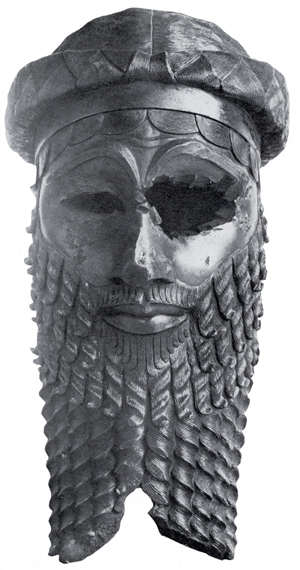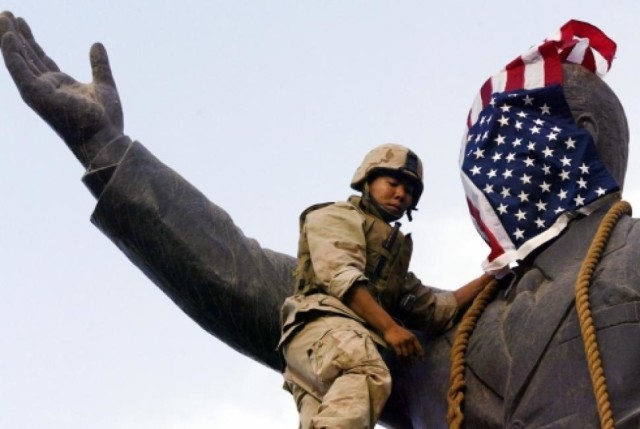
Still from a video posted to a social media account affiliated with Islamic State. Image courtesy of the AP.
Art gives power to the already-powerful. But when the powerful are dethroned, their art usually comes tumbling down with them. That’s political iconoclasm: the destruction of statues, monuments, and images by those newly in power. Out with the old, in with the new.
As of late, the media has started shedding light on the iconoclasm of Islamic State. In February, videos showing Islamic State (IS) members beheading ancient stone statues popped up in news and social media streams. Last week, IS took over Palmyra, a UNESCO World Heritage site in Syria, bringing about worries of a second artwork destruction spree. I personally have a hard time writing about iconoclasm and IS—one little fairy on my shoulder tells me that other people are better qualified—but there is something important happening here.
Islamic State has reinvented the terms of iconoclasm, and shows that it’s about more than art. At the same time, artists and writers from the Middle-Eastern diaspora have been addressing concerns about the destruction of their countries’ architecture by a new class of elites. Both are iconoclasm.
Iconoclasm Is Nothing New

Bronze head, usually attributed to Sargon of Akkad. The eyes have been gouged out, the beard chopped off. The latter has been referred to as “symbolic castration.”
From east to west, those newly in power often destroy the images and idols of a former regime. We have early examples, like a bust of an Akkadian ruler, usually attributed to Sargon the Great (23rd to 22nd century B.C.)—it’s often shown in Art History 101 classes—the eyes have been gouged-out, the nose and ears destroyed, as a symbolic, politically motivated attack on a now-dead ruler. In this century, we need only look to U.S. troops toppling statues of Saddam Hussein to see how smashing a statue pushes marble dust into the waste-bin of history.

Image: Goran Tomasevic/Reuters.
History, Bulldozed
There might be no better example of extreme iconoclasm than pushing down colossus-size men to the ground. But less explicit iconoclasm has been happening in the Middle East as it has become the modern oil zenith we know it as today, and this has prompted serious concerns from those interested in the future of the region.
Ziauddin Sardar, editor of the quarterly magazine Critical Muslim, penned an op-ed in the New York Times describing the architectural devastation of Mecca: no single historical site remains out of reach for those in power, who want to cover up the past with the glitter of a singular Modernism, rather than a plurality of Middle-Eastern visions, its sects, cultures, and so forth. The 1970s inaugurated Mecca’s modern era, with ancient buildings destroyed in the name of this type of development. He writes: “Innumerable ancient buildings, including the Bilal mosque, dating from the time of the Prophet Muhammad, were bulldozed. The old Ottoman houses, with their elegant mashrabiyas — latticework windows — and elaborately carved doors, were replaced with hideous modern ones. Within a few years, Mecca was transformed into a ‘modern’ city with large multilane roads, spaghetti junctions, gaudy hotels and shopping malls.”
Despite being the site of annual pilgrimage, on a daily basis, Mecca looks like one of the new playgrounds for the global rich: shiny, tall, and out of reach for the majority of the city’s residents.
Sardar’s fear—of former empires razed to create shopping —is not singular. Though I didn’t connect the dots at the time, several of the works in the New Museum’s 2014 survey of the Arab art world, Here and Elsewhere, expressed that fear as well. Perhaps I didn’t notice because these works had already given up on saving the past: it was already too late. Wafa Hourani’s “Qalandia 2087” shows glue-and-glitter assembled doll-house dioramas of a devastated Israel, and Maha Maamoun’s “2026” describes a city covered in pristine holograms that obscure the city’s reality—full of poor citizens and unwanted ruins.

At the New Museum: Wafa Hourani’s “Qalandia 2087.”
Islamic State’s Networked Iconoclasm
IS, though, does not practice iconoclasm merely for the sake of destruction alone. Sales of looted goods fund their operations. “These are not some lovers of art,” Unesco’s director-general, Irina Bokova, told the BBC. “This is part of the financing of extremism and it is absolutely imperative that we stop these channels of illicit trafficking.” She went on to say that it’s not just artifacts that they’re selling on the black market, but also sex slaves and drugs. Art belongs to the same network as drugs and slaves? Yes, it is just one of a type of rare vanities, and does not belong to a class of its own.
“Gazing up into the darkness I saw myself as a creature driven and derided by vanity; and my eyes burned with anguish and anger.” —From James Joyce’s short-story “Araby”
IS knows what men and women are willing to pay for; power is not held by getting rid of the past through simple vandalism. Power is capital. It destroys, not just through physical means (smashing sculptures) but by upending traditional networks of capital. The black market does not abide by any generally acceptable rules of capital—you do not need banks, currency exchanges, or regulators.
Traditional iconoclasm symbolically destroys political regimes; this networked iconoclasm symbolically destroys economic regimes.
At its current rate, IS seems poised to undertake more than symbolic destruction. The U.S. Treasury department estimates that IS rakes in more than $1 million a day from black-market oil sales alone. “With the important exception of some state-sponsored terrorist organizations, IS is probably the best-funded terrorist organization we have confronted,” says David Cohen, undersecretary for terrorism and financial intelligence, according to the Associated Press.
For too long, iconoclasm has been too focused on the image. A new reworking of iconoclasm needs to be focused on the network. Has looting always occurred? We can be sure that it has, but never at this specific scale where IS has turned symbolic destruction into a rather practical means of continuing its existence.


Comments on this entry are closed.